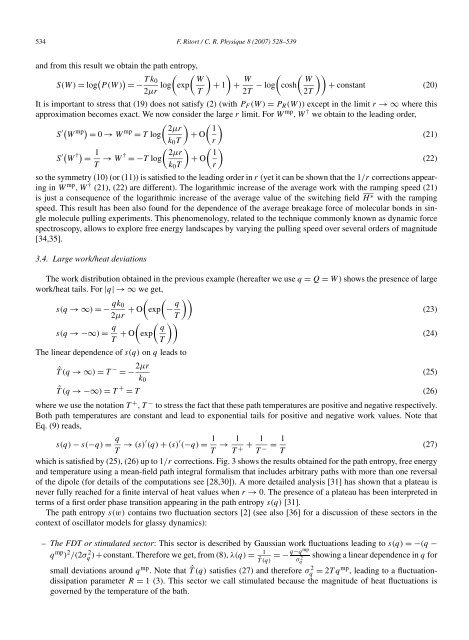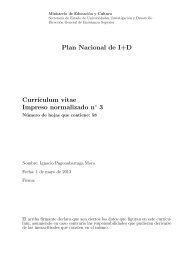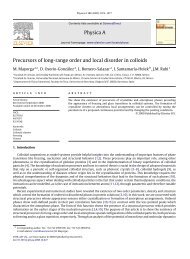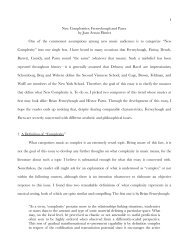The nonequilibrium thermodynamics of small systems
The nonequilibrium thermodynamics of small systems
The nonequilibrium thermodynamics of small systems
You also want an ePaper? Increase the reach of your titles
YUMPU automatically turns print PDFs into web optimized ePapers that Google loves.
534 F. Ritort / C. R. Physique 8 (2007) 528–539and from this result we obtain the path entropy,S(W) = log ( P(W) ) =− Tk ( ( ) )0 W2μr log exp + 1 + W ( ( )) WT 2T − log cosh + constant (20)2TIt is important to stress that (19) does not satisfy (2) (with P F (W ) = P R (W )) except in the limit r →∞where thisapproximation becomes exact. We now consider the large r limit. For W mp ,W † we obtain to the leading order,S ′( W mp) ( ) ( )2μr 1= 0 → W mp = T log + O(21)k 0 T rS ′( W †) = 1 ( ) ( )2μr 1T → W † =−T log + O(22)k 0 T rso the symmetry (10) (or (11)) is satisfied to the leading order in r (yet it can be shown that the 1/r corrections appearingin W mp ,W † (21), (22) are different). <strong>The</strong> logarithmic increase <strong>of</strong> the average work with the ramping speed (21)is just a consequence <strong>of</strong> the logarithmic increase <strong>of</strong> the average value <strong>of</strong> the switching field H ∗ with the rampingspeed. This result has been also found for the dependence <strong>of</strong> the average breakage force <strong>of</strong> molecular bonds in singlemolecule pulling experiments. This phenomenology, related to the technique commonly known as dynamic forcespectroscopy, allows to explore free energy landscapes by varying the pulling speed over several orders <strong>of</strong> magnitude[34,35].3.4. Large work/heat deviations<strong>The</strong> work distribution obtained in the previous example (hereafter we use q = Q = W ) shows the presence <strong>of</strong> largework/heat tails. For |q|→∞we get,s(q →∞) =− qk ( (02μr + O exp − q ))(23)Ts(q →−∞) = q ( )) q(expT + O (24)T<strong>The</strong> linear dependence <strong>of</strong> s(q) on q leads toˆT(q→∞) = T − =− 2μr(25)k 0ˆT(q→−∞) = T + = T (26)where we use the notation T + ,T − to stress the fact that these path temperatures are positive and negative respectively.Both path temperatures are constant and lead to exponential tails for positive and negative work values. Note thatEq. (9) reads,s(q) − s(−q) = q T → (s)′ (q) + (s) ′ (−q) = 1 T → 1T + + 1T − = 1 (27)Twhich is satisfied by (25), (26) up to 1/r corrections. Fig. 3 shows the results obtained for the path entropy, free energyand temperature using a mean-field path integral formalism that includes arbitrary paths with more than one reversal<strong>of</strong> the dipole (for details <strong>of</strong> the computations see [28,30]). A more detailed analysis [31] has shown that a plateau isnever fully reached for a finite interval <strong>of</strong> heat values when r → 0. <strong>The</strong> presence <strong>of</strong> a plateau has been interpreted interms <strong>of</strong> a first order phase transition appearing in the path entropy s(q) [31].<strong>The</strong> path entropy s(w) contains two fluctuation sectors [2] (see also [36] for a discussion <strong>of</strong> these sectors in thecontext <strong>of</strong> oscillator models for glassy dynamics):– <strong>The</strong> FDT or stimulated sector: This sector is described by Gaussian work fluctuations leading to s(q) =−(q −q mp ) 2 /(2σq 2 1)+constant. <strong>The</strong>refore we get, from (8), λ(q) =ˆT(q) =−q−qmp showing a linear dependence in q forσq2<strong>small</strong> deviations around q mp . Note that ˆT(q) satisfies (27) and therefore σq 2 = 2Tqmp , leading to a fluctuationdissipationparameter R = 1 (3). This sector we call stimulated because the magnitude <strong>of</strong> heat fluctuations isgoverned by the temperature <strong>of</strong> the bath.





